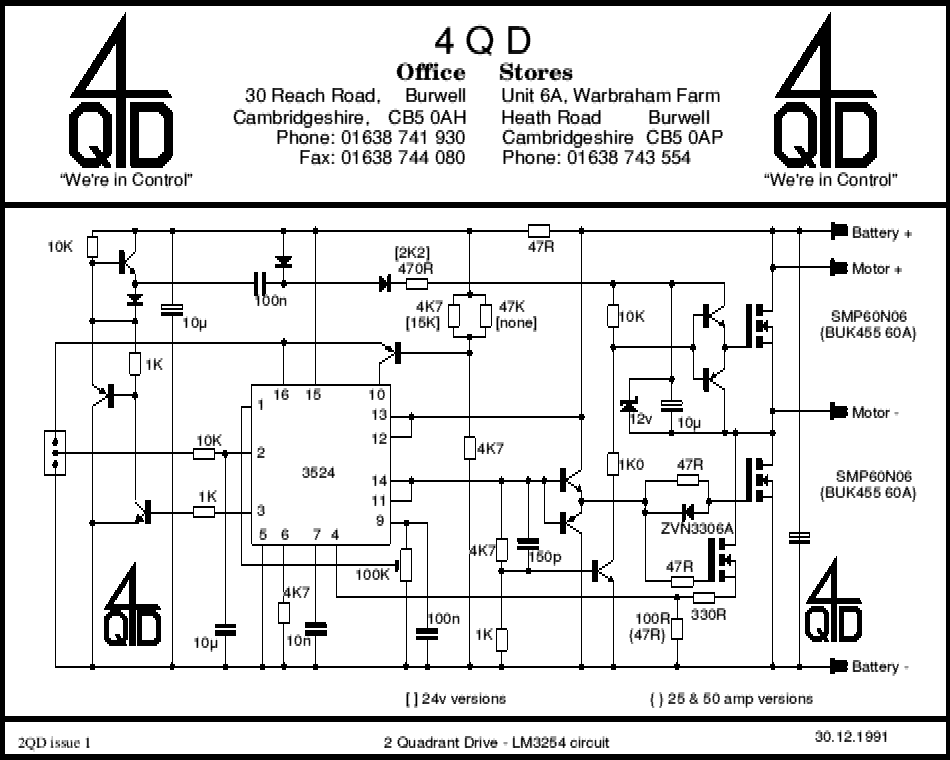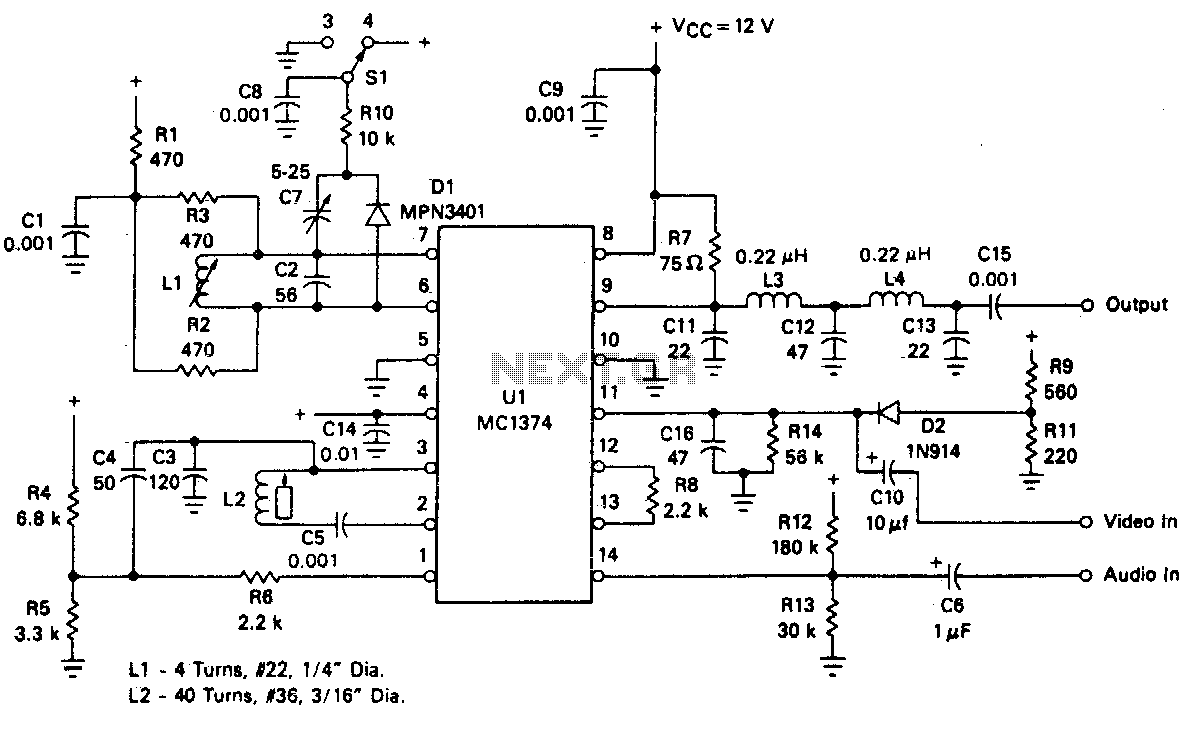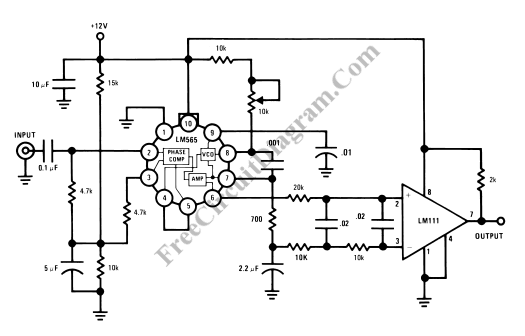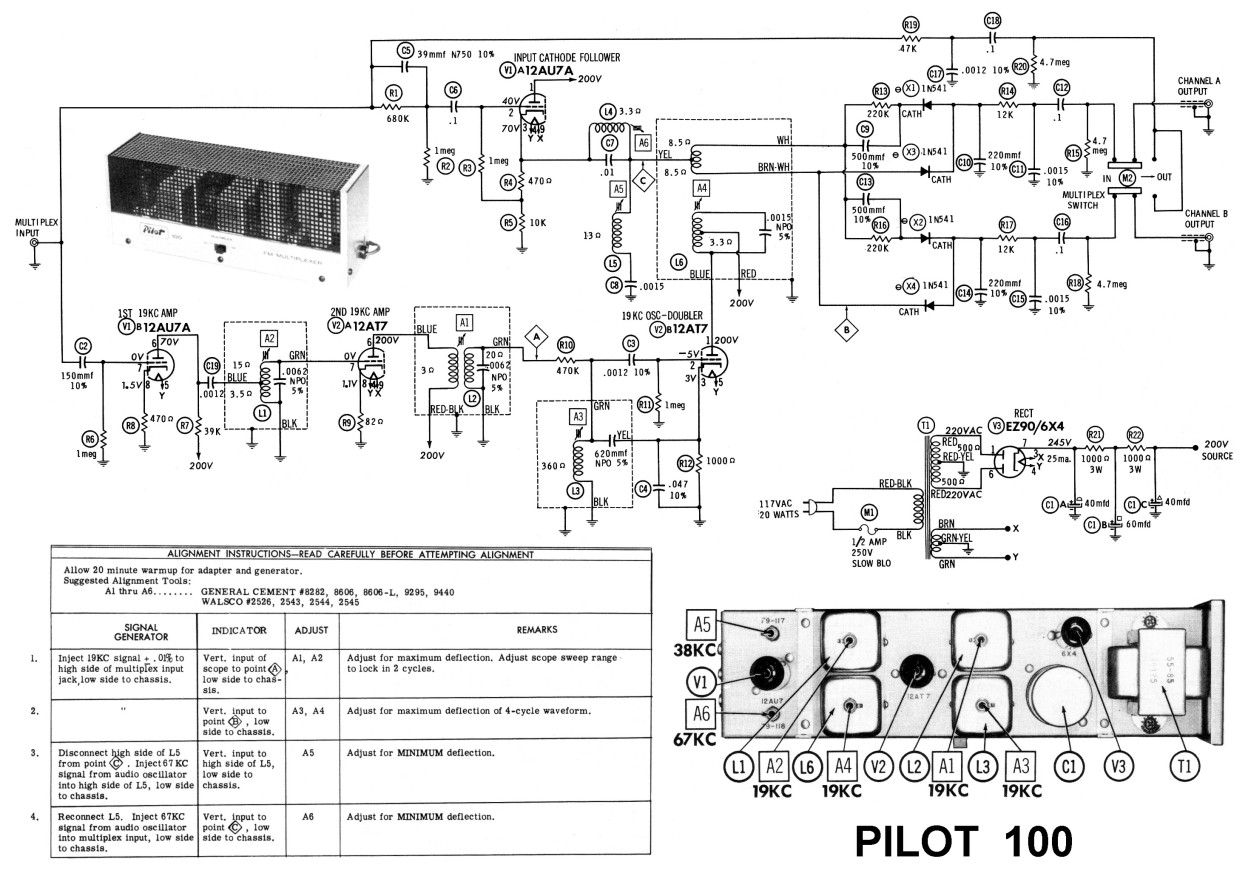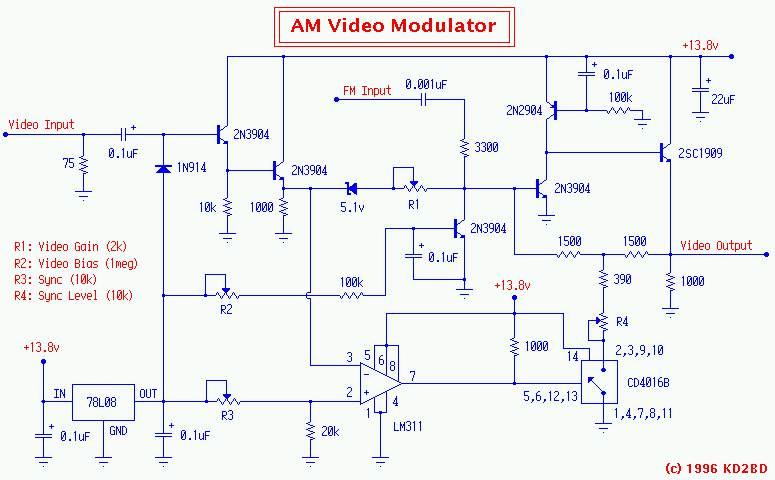
PWM Modulator
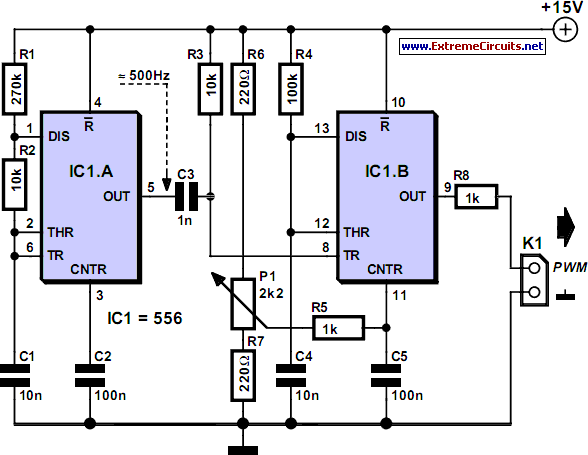
If one has considered experimenting with pulse-width modulation, this circuit serves as an excellent starting point. The design prioritizes simplicity by utilizing a dual 555 timer, making the assembly straightforward. A small PCB has been created for this purpose, facilitating the building process. This circuit is not original and is intended as an enhancement to the "Dimmer with MOSFET" article available on this website. The design has been specifically tailored for this application. A frequency of 500 Hz has been selected, dividing each half-period of the dimmer into five segments, as a lower frequency generates less interference. The first timer is configured as a standard astable frequency generator. Details on its operation can be easily found in datasheets and application notes. The frequency is calculated using the formula 1.49 / (R1 + 2R2) × C1 [Hz], where R2 is kept small to allow for easy variation of the frequency by adjusting R1 and/or C1. The second timer functions as a monostable multivibrator, triggered by a differentiator constructed from R3 and C3. The trigger input responds to a rising edge. A low level at the trigger input causes the output of the timer to go low. R3 and C3 are included to maximize the control range. The pulse width of the monostable timer is determined by 1.1 × R4 × C4, which in this case equals just over a millisecond, approximately half the period of IC1a. The pulse width can be varied using P1 to adjust the voltage at the CNTR input, which modifies the voltage to the internal comparators of the timer, thus altering the time required to charge C4. The control range is also influenced by the supply voltage; therefore, a supply voltage of 15V has been selected. The voltage range of P1 is limited by resistors R6, R7, and R5. In this design, the control voltage fluctuates between 3.32 V and 12.55 V (the prototype supply voltage was 14.8 V). The output becomes active only when the voltage reaches 3.51 V, resulting in a duty cycle of 13.5%. This initial "quiet" range ensures that the lamp remains off. R8 serves to protect the output against short circuits. With the opto-coupler of the dimmer as the load, the maximum current consumption of the circuit is approximately 30 mA.
The circuit's design employs two 555 timers, one configured as an astable multivibrator and the other as a monostable multivibrator. The astable timer generates a continuous square wave at 500 Hz, with the frequency adjustable through the resistors R1 and R2, and capacitor C1. The configuration allows for a low-frequency output, minimizing electromagnetic interference during operation, which is critical in applications where signal integrity is paramount.
The monostable timer is activated by a differentiator circuit composed of R3 and C3, which ensures that the timer is triggered by a rising edge, establishing a pulse-width modulation effect. The pulse width is adjustable via potentiometer P1, allowing for fine control over the duty cycle by altering the voltage at the CNTR input. This feature enhances the versatility of the circuit, making it suitable for various dimming applications.
The output stage includes R8, which is a protective resistor that safeguards the circuit against potential short circuits, ensuring reliability and longevity. The design also incorporates a voltage regulation aspect, as the supply voltage impacts the overall control range. By utilizing a 15V supply, the circuit maintains optimal performance, with the output becoming active only when the control voltage exceeds a specified threshold.
In summary, this pulse-width modulation circuit offers a simple yet effective solution for controlling the brightness of lamps or other loads through a well-designed dual 555 timer configuration. The careful selection of components and the inclusion of protective features make it a robust choice for experimentation and practical applications in electronic dimming solutions.If you ever thought of experimenting with pulse-width modulation, this circuit should get you started nicely. We`ve kept simplicity in mind and used a dual 555 timer, making the circuit a piece of cake. We have even designed a small PCB for this, so building it shouldn`t be a problem at all. This certainly isn`t an original circuit, and is here ma inly as an addition to the Dimmer with MOSFET` article elsewhere in this website. The design has therefore been tailored to this use. A frequency of 500 Hz was chosen, splitting each half-period of the dimmer into five (a low frequency generates less interference). The first timer is configured as a standard astable frequency generator. There is no need to explain its operation here, since this can easily be found on the Internet in the datasheet and application notes.
All we need to mention is that the frequency equals 1. 49 / (R1+2R2) G— C1) [Hz] R2 has been kept small so that the frequency can be varied easily by adjusting the values of R1 and/or C1. The second timer works as a monostable multivibrator and is triggered by the differentiator constructed using R3 and C3.
The trigger input reacts to a rising edge. A low level at the trigger input forces the output of the timer low. R3 and C3 have therefore been added, to make the control range as large as possible. The pulse-width of the monostable timer is given by 1. 1xR4xC4 and in this case equals just over a millisecond. This is roughly half the period of IC1a. The pulse-width is varied using P1 to change the voltage on the CNTR input. This changes the voltage to the internal comparators of the timer and hence varies the time required to charge up C4. The control range is also affected by the supply voltage; hence we`ve chosen 15V for this. The voltage range of P1 is limited by R6, R7 and R5. In this design the control voltage varies between 3. 32 V and 12. 55 V (the supply voltage of the prototype was 14. 8 V). Only when the voltage reaches 3. 51 V does the output become active, with a duty-cycle of 13. 5 %. The advantage of this initial quiet` range is that the lamp will be off. R8 protects the output against short circuits. With the opto-coupler of the dimmer as load, the maximum current consumption of the circuit is about 30 mA.
🔗 External reference
The circuit's design employs two 555 timers, one configured as an astable multivibrator and the other as a monostable multivibrator. The astable timer generates a continuous square wave at 500 Hz, with the frequency adjustable through the resistors R1 and R2, and capacitor C1. The configuration allows for a low-frequency output, minimizing electromagnetic interference during operation, which is critical in applications where signal integrity is paramount.
The monostable timer is activated by a differentiator circuit composed of R3 and C3, which ensures that the timer is triggered by a rising edge, establishing a pulse-width modulation effect. The pulse width is adjustable via potentiometer P1, allowing for fine control over the duty cycle by altering the voltage at the CNTR input. This feature enhances the versatility of the circuit, making it suitable for various dimming applications.
The output stage includes R8, which is a protective resistor that safeguards the circuit against potential short circuits, ensuring reliability and longevity. The design also incorporates a voltage regulation aspect, as the supply voltage impacts the overall control range. By utilizing a 15V supply, the circuit maintains optimal performance, with the output becoming active only when the control voltage exceeds a specified threshold.
In summary, this pulse-width modulation circuit offers a simple yet effective solution for controlling the brightness of lamps or other loads through a well-designed dual 555 timer configuration. The careful selection of components and the inclusion of protective features make it a robust choice for experimentation and practical applications in electronic dimming solutions.If you ever thought of experimenting with pulse-width modulation, this circuit should get you started nicely. We`ve kept simplicity in mind and used a dual 555 timer, making the circuit a piece of cake. We have even designed a small PCB for this, so building it shouldn`t be a problem at all. This certainly isn`t an original circuit, and is here ma inly as an addition to the Dimmer with MOSFET` article elsewhere in this website. The design has therefore been tailored to this use. A frequency of 500 Hz was chosen, splitting each half-period of the dimmer into five (a low frequency generates less interference). The first timer is configured as a standard astable frequency generator. There is no need to explain its operation here, since this can easily be found on the Internet in the datasheet and application notes.
All we need to mention is that the frequency equals 1. 49 / (R1+2R2) G— C1) [Hz] R2 has been kept small so that the frequency can be varied easily by adjusting the values of R1 and/or C1. The second timer works as a monostable multivibrator and is triggered by the differentiator constructed using R3 and C3.
The trigger input reacts to a rising edge. A low level at the trigger input forces the output of the timer low. R3 and C3 have therefore been added, to make the control range as large as possible. The pulse-width of the monostable timer is given by 1. 1xR4xC4 and in this case equals just over a millisecond. This is roughly half the period of IC1a. The pulse-width is varied using P1 to change the voltage on the CNTR input. This changes the voltage to the internal comparators of the timer and hence varies the time required to charge up C4. The control range is also affected by the supply voltage; hence we`ve chosen 15V for this. The voltage range of P1 is limited by R6, R7 and R5. In this design the control voltage varies between 3. 32 V and 12. 55 V (the supply voltage of the prototype was 14. 8 V). Only when the voltage reaches 3. 51 V does the output become active, with a duty-cycle of 13. 5 %. The advantage of this initial quiet` range is that the lamp will be off. R8 protects the output against short circuits. With the opto-coupler of the dimmer as load, the maximum current consumption of the circuit is about 30 mA.
🔗 External reference
Warning: include(partials/cookie-banner.php): Failed to open stream: Permission denied in /var/www/html/nextgr/view-circuit.php on line 713
Warning: include(): Failed opening 'partials/cookie-banner.php' for inclusion (include_path='.:/usr/share/php') in /var/www/html/nextgr/view-circuit.php on line 713
